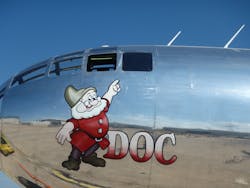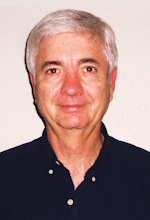In early September our hard working Senior Editor Barb Zuehlke sent an email asking if I was one of Doc's Friends. My initial reaction was “HUH” followed by a quick reply of tell me more. I followed a link to some media releases about this B-29 Superfortress restoration project going on at Wichita, KS. Doc, a beautiful B-29, is named after one of Snow White’s seven dwarfs. This article is about the dreamers and romantics and hardworking designers, engineers, builders, pilots, maintainers, owners, and operators that are the heart and soul of our industry. We often get caught up in the challenges of worldwide competition: the mergers, consolidation, and restructuring, labor contracts, new procedures, new technology, customer demands, regulatory changes, and day-to-day life. We sometimes forget why we work in this crazy industry. Doc is a story that reminds us of the human side of our industry.
For us aviation history buffs the B-29 was one of those aircraft that represented true innovation in aircraft design. The structures, systems, armament, and avionics were exponentially different from the B-17s and a test bed for that technology that would become standard for post war aircraft. The technological innovations included a huge new airframe with green house windows up front and blister windows on the side, electrical-operated components, and new Wright R-3350-57 Cyclone engines delivering 2,200 horsepower per engine, new 13-foot propellers, a new pressurization system for crew compartments, centralized gun controls, and a new high-lift wing design. This wing design was critical because it had to provide the lift for 20,000 pounds of high explosives and the fuel load necessary to make it across the vast Pacific to targets in Japan. These classic bombers were built by many that left the farms and fields of Kansas to build 1,644 B-29 at the Boeing Plant in Wichita. One of those Rosy the Riveters was an 18-year-old young lady named Connie Palacioz. In 1945 she helped build Doc and now at 90 is part of Doc’s restoration crew.
After a lengthy service life Doc was decommissioned and like so many others flown to the bone yard at the China Lake Naval Warfare Center Weapons Center in California. While there the Navy pilots used Doc for target practice and the starlings, wrens, and rats had their way as well. Then in 1987 a group of dedicated aviation fans led by Tony Mazzolini turned an obsession into a plan to restore the Doc to that unimaginable airworthy status.
The B-29 Superfortress was designed with a specific purpose: To fly high and far and carry large loads of munitions in order to reduce the enemies' will to wage war against the United States of America. It was a sliverplate B-29 produced a short walk from where Doc sits that was personally selected by General Paul Tibbets that helped bring a dramatic end to the war in the Pacific. Not a frumpy cute little Disney character for sure. Doc's original engines were 3350-57, and the new engines are a mix of the 3350-95 and a 26WD off the old Douglas A-1 Skyraider single-seat attack airplane engines. Doc's new engines were manufactured by Idaho-based Anderson Aeromotive.
The Restoration Process
Doc’s resusitation began in the desert but according to Tom Bertels, a Doc's Friends board member and marketing steering committee chair, the challenges of desert weather and the lack of skilled maintenance technicians was a bridge too far for Tony. Doc needed a champion, a change of scenery, and some TLC from some new and old fans. The new home was Wichita, KS, an aviation manufacturing center with a huge pool of retirees that could be recruited.
Doc arrived in pieces on trucks and trains in 2000; however, the restoration work waxed and waned because of a variety of issues including funding challenges brought on by the 2007-08 recession.
In 2013 Doc’s champion arrived, former Spirit AeroSystems CEO Jeff Turner quickly recruited a team of successful Wichita businessmen and established a 501c3 nonprofit organization called “Doc’s Friends.” The board of directors included Charlie Chandler, Jack Pelton, Steve Clark, Lynn Nichols, Brad Gorsuch, Vic McMullen, Ron Ryan, Tim Buchanan, Jeff Peier, Esq., and Tom Bertels. The board began marshaling necessary resources and recruiting manpower to complete Doc’s make over. Spirit AeroSystems asked one of its senior employees, Jim Murphy, to be its representative on the project. Murphy is a second generation Boeing employee and had retired after 30 years with Boeing and another 10 with Spirit. Another Boeing retiree, T.J. Norman, was recruited as project manager and these two made the perfect match for Doc’s restoration. The restoration group now includes a board of directors, a great management team, and a squadron of aircraft polishers, tin benders, spark chasers, and wrenches including some of the original builders like riveter Connie Palacioz.
When I called Murphy to ask for an interview and a visit with Doc he was rigging engine cowlings. This was a busy week for the restoration team because the first engine run was scheduled for 8:00 a.m. on Sept. 18. He agreed to fit me in on Wednesday for the interview and walk around.
I arrived at the Wichita, KS, Dwight D. Eisenhower National Airport around 10:00 a.m. and on the way out Murphy pointed to a vacant section of the airport and mentioned that the long-term plan for that space was to develop that area as an aviation museum displaying some of the famous, general, business, military, and commercial aircraft that had been produced at Wichita. Also, if all goes according to Doc’s Friends' plans there would be home for the B-29 when Doc is not out on missions.
As we drove Murphy gave me the back story and chronology of Doc’s restoration, including challenges and the successes. He makes it very clear that the successes were due totally to the contribution of the many volunteers, like electrician Max Parkhurst, that spend their retirement days restoring Doc.
We drove past the Air Capital hangar and I saw Doc for the first time. My reaction and comments brought a chuckle from Murphy. He says many of his passengers are stunned and get a bit misty eyed the first time they meet Doc. Doc sits high on tall tricycle gears, polished beyond new, shining bright in the Kansas sun. The B-29 is a big airplane, empty weight 71,361 pounds, a long slim fuselage (99.02 feet), thin long wings, (142.26 feet), a high fin (29.56 feet), and engines and props that appear to be too big for the wings. With the green house front and the stinger in the tail, Doc looks almost like one of those dragons in video games or science fiction movies.
According to Murphy the work scheduled for the day was to pre oil the engines getting them ready for the engine run on Friday. A crew of engine mechanics was up to their elbows removing sparkplugs in order to “burp” the engines. Friday’s engine run would be a very big milestone indeed; there would be lots of press sponsors, fans and volunteers, and a live feed for all on Doc's website: www.b-29doc.com. Turner would be in the left seat and Tony Mazzolini who had been waiting for this day for about 15 years would be in the right. Watching the video of the engine run up, I saw TJ lean out the window and pat Doc on the nose for good luck and maybe to wake Doc up because he had been asleep for about 28 years. No. 3, 4, and 1 started on turnover. No. 2 was a little temperamental, but started after some pampering from the flight engineer; after all it is a radial.
As we continued our walk around, it was interesting to see innovations in the B-29, like the advanced electrical systems, avionics, blister windows, centralized fire control for guns, pressured cabins, and so on, yet the flight controls were dope and fabric. The engines were massive and the original four-bladed props were in perfect condition, not one nick or ding. There were a few oil drips in the pans.
T. J. Norman stopped work and joined us for the interviews, walk around, and tour inside Doc. As we walked Jim and TJ would point out projects that sponsors and key volunteers had completed. Early on they had discovered that the wing spar cords had corrosion and needed to be replaced. This is heavy structure work so Spirit AeroSystems stepped up and built new spar cords and the massive attaching hardware.
Innovative for its time
Inside the B-29 is an elegant, clean airplane as slim and trim as a Kansas greyhound, no wasted space, or excess weight in here. The B-29 was an electrical airplane and all the wiring and around 200 electrical motors had to be replaced or rebuilt and recertified. One surprise was that the B-29 is an “arm strong airplane”, no hydraulics or electrical assist for the huge flight controls. This certainly speaks to the aerodynamics and balance of this airplane. The entire pulley assemblies and cables were new. The only hydraulics components were the brakes. Interestingly, the B-29 did not have nose wheel steering, it was controlled on the ground by brakes and engine throttles.
With the exception of the tail gunners, the crew compartments were roomy and should have been comfortable for members of the 73 Bomb group making the long hauls from bases on Tinian and Saipan in the Northern Mariana’s to main land Japan and back. I had an opportunity to sit in the flight engineer's seat and scan all the systems and engine gauges. The hatches were open and that predictable Kansas wind was blowing and you could feel Doc tugging at the tie down and you could hear that creaking and ole soft moan that airplanes make.
The Next Step
“After successful engine runs we will get our Airworthiness Certificate from the FAA," Murphy says. "We don’t anticipate any problems because the FAA has been right with us through all of our major milestones. Once the certificate is issued, Doc’s Friends will petition the U.S. Air Force requesting approval to operate Doc from McConnell Air Force Base during the flight-testing phase. Doc’s Friends’ board of directors approved the launch of a Kickstarter crowdfunding campaign to help fund the costs of conducting the flight-testing phase of the program.” Murphy expects that Doc could be flying by the end of 2015 and could be doing flyovers at the EAA event in Oshkosh, WI, in 2016.
After visiting Doc at Wichita and talking with Jim Murphy, T.J. Norman, and other volunteers like electrician Max Parkhurst. It reminded me just how great our American aviation industry is. It made me remember how special our experimenters, designers, and dreamers are from the Wright Brothers and Charlie Taylor to Tony Mazzolini. My hope is that each technician that enters our industry recognizes that we have a long tradition of building and maintaining beautiful machines and that each has the opportunity to work on crews with the likes of Rosy the Riveter Connie Palacioz or men like Murphy and Norman that dedicate their time to a classic like Doc.
The next time you are sitting in old airplane and the wind is blowing, listen for that song, the one that started at Kitty Hawk, that goes across the ramp in Wichita, and across the desert bone yards and can probably be heard on the international space station and one day beyond. It is that melody that connects all aviators and reminds us that we are most content when we are with our flying machines.



